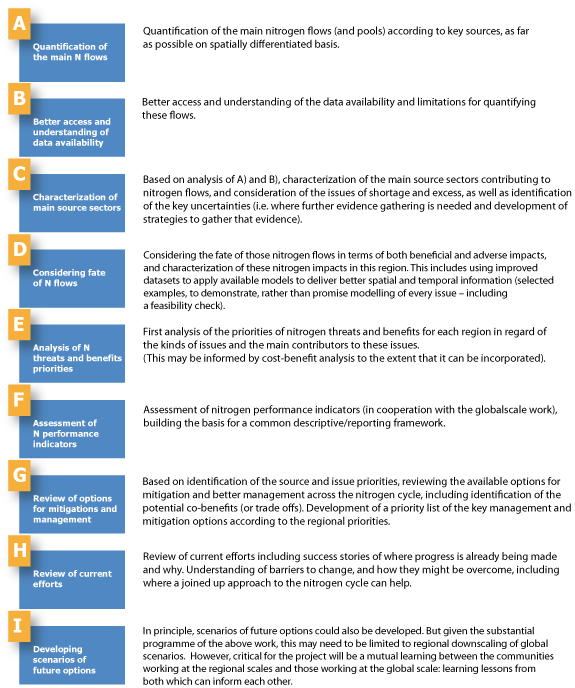Introduction to the Demonstration Activities
The key purpose of the Towards INMS Regional Demonstrations is to demonstrate how a cross-cutting approach that links different parts of the nitrogen cycle, including the benefits and threats, can deliver a stronger gravity for better management of these issues. We could call it the ‘nitrogen snowball’ where joining up the snowflakes gives much bigger impact. Some questions and answers about the Demonstration Activities are given below.
This information is also available as a pdf file, which you can find here.
How does regional demonstration link to the global approach?
Global analysis has the advantage of linking the different key issues enabling quantification of how they fit together. By contrast, global analyses will necessarily lack important details relevant at the regional scale, for example about how practices differ, the priorities between key nitrogen issues, and the opportunities and barriers to change. Each of these can be expected to differ between regions.
INMS therefore includes a strong focus on regional demonstration where we map the developing ideas of INMS into different key world regions. This also provides a basis to start to interact at sub-regional and local levels which is important in developing stakeholder engagement.
What do you mean by the word demonstration?
The word demonstration is one commonly used in GEF projects, but there are many different kinds of demonstration. In Towards INMS we aim to demonstrate how a cross cutting approach that joins up different parts of the nitrogen cycle, including the benefits and threats, can deliver a stronger gravity for better management of these issues. We could refer to it as the nitrogen snowball – where joining up the snowflakes gives much bigger impact.
As a targeted research project, the regional work of Towards INMS is therefore primarily scientific demonstration – focused on evidence gathering. However, part of the nitrogen challenge involves understanding better what are the limitations to action and what are the key drivers for action. Therefore, the regional demonstration helps to provide more concrete information on how key world regions face a mix of similar and contrasting challenges. This is critical information that can then inform developing approaches at the global scale.
How many INMS regional demonstrations do you anticipate?
The number of regional demonstrations in Towards INMS is not exactly fixed yet. The principles in the guidance from GEF have been that we develop sufficient critical mass to support and inform a global approach, where all the key regions are included. On the other hand, the resources for GEF demonstration are primarily targeted at developing and transition economies.
With this in mind we have four categories of regional demonstration included a) developing regions with two much nitrogen, b) developing regions with too little nitrogen, c) transition economies, often with problems of too much nitrogen, and d) developed economies with too much nitrogen. The last of these is included where other national and international funding resources allow it (i.e. beyond the GEF resources).
At present we are looking towards mapping this out with the following five demonstrations funded directly through Towards INMS: a) South Asia, East Asia, Latin America, b) East Africa, c) East Europe. In regard of d) we have an offer for engagement from West Europe (Atlantic coast) but other regions may also be possible.
What should a demonstration ‘region’ look like in Towards INMS?
There is no exact size to a region, but common issues can be identified. In particular, we see INMS regions as being characterized by more than one country allowing transboundary challenges to be addressed (both in water and air, but also considering policy and trade interactions). In practice (for achievability) groups of perhaps 3 to 5 countries working together looks optimal.
Secondly, each regional demonstration should ideally have at least one existing intergovernmental policy process which it would directly support. This provides a mechanism for direct engagement between science and policy at the regional scale. For example, in the case of South Asia (provisionally India, Bangladesh, Sri Lanka, Nepal, but potentially others), we envisage a direct partnering with the South Asian Cooperative Environment Programme (SACEP). Each of the regions should develop the relationship with the key regional policy audience.
The choice of the INMS region boundaries would also naturally link to some part or parts of the nitrogen cycle. For example, in the case of East Africa, we consider the Lake Victoria catchment, which links Kenya, Uganda, Tanzania and Burundi. In the case of East Europe, we consider selected key catchments running into the Black Sea. In the case of East Asia, there are major challenges for eutrophication of the pacific coastal waters as well as common regional air pollution through nitrogen, therefore we consider linking countries around this domain (e.g. China, Japan, Philippines, South Korea). This workshop is a step on the way towards refining these ideas and the partnerships necessary.
What kind of work would Towards INMS fund in the regional demonstrations?
We envisage developing a broadly common approach to be replicated for each of the INMS demonstration regions. The aim is to develop an approach that is comparable, while recognizing that the detailed priorities and challenges faced by each region will differ. By taking a common approach, the report of the regional work to the overall Towards INMS process, will therefore allow us to better characterize both the common challenges and opportunities and the specific regional challenges of each.
The following evidence stages can be considered, for which evidence needs to be gathered.




 GEF IW:LEARN
GEF IW:LEARN


